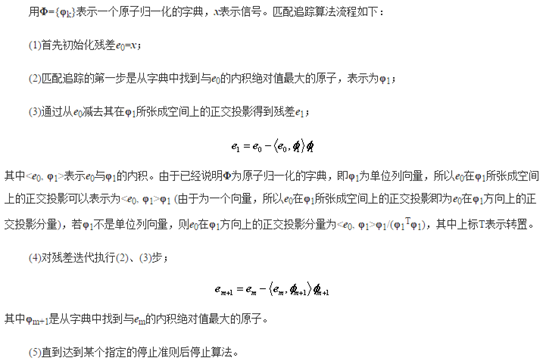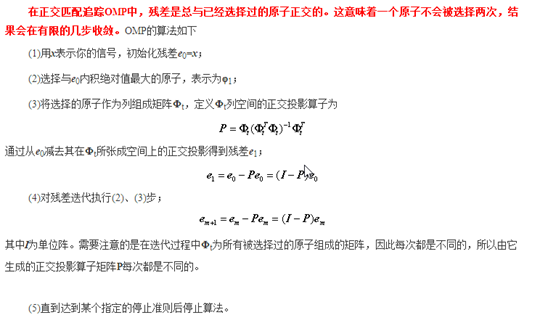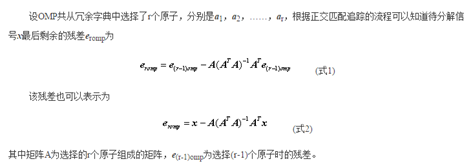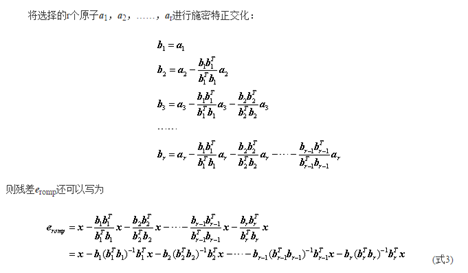浅谈压缩感知(十九):MP、OMP与施密特正交化
关于MP、OMP的相关算法与收敛证明,可以参考:http://www.cnblogs.com/AndyJee/p/5047174.html,这里仅简单陈述算法流程及二者的不同之处。
主要内容:
- MP的算法流程及其MATLAB实现
- OMP的算法流程以及MATLAB实现
- MP与OMP的区别
- 施密特正交化与OMP的关系
一、MP(匹配追踪)的算法流程:

二、MP的MATLAB实现:
% MP:匹配追踪算法 % dictionary: 超完备字典 % x: 待表示信号 % M = 4; N = 10; % Phi = randn(M,N); % 字典 % for nn = 1:N % Phi(:,nn) = Phi(:,nn)/norm(Phi(:,nn)); % end % b = randn(M,1); % 信号 function x = MP(dictionary,x,iter) [M,N] = size(dictionary); residual = zeros(M,iter); %残差矩阵,保存每次迭代后的残差 residual(:,1) = x; %初始化残差为x L = size(residual,2); %得到残差矩阵的列 pos_num = zeros(1,L); %用来保存每次选择的列序号 resi_norm = zeros(1,L); %用来保存每次迭代后的残差的2范数 resi_norm(1) = norm(x); %因为前面已初始化残差为x iter_out = 1e-3; iter_count = 0; for mm = 1:iter %迭代退出条件 if resi_norm(mm) < iter_out break; end %求出dictionary每列与上次残差的内积 scalarproducts = dictionary'*residual(:,mm); %找到内积中最大的列及其内积值 [val,pos] = max(abs(scalarproducts)); %更新残差 residual(:,mm+1) = residual(:,mm) - scalarproducts(pos)*dictionary(:,pos); %计算残差的2范数(平方和再开根号) resi_norm(mm+1) = norm(residual(:,mm+1)); %保存选择的列序号 pos_num(mm) = pos; iter_count = iter_count + 1; end %绘出残差的2范数曲线 resi_norm = resi_norm(1:iter_count+1); plot(resi_norm);grid; %显示选择的字典原子 pos_num = pos_num(1:iter_count); disp(pos_num); %稀疏系数(稀疏表示) dict = dictionary(:,pos_num); y_vec = (dict'*dict)^(-1)*dict'*x; disp(y_vec); figure;plot(y_vec);
三、OMP(正交匹配追踪)的算法流程:

四、OMP的MATLAB实现:
% MP:匹配追踪算法 % dictionary: 超完备字典 % x: 待表示信号 % M = 4; N = 10; % Phi = randn(M,N); % 字典 % for nn = 1:N % Phi(:,nn) = Phi(:,nn)/norm(Phi(:,nn)); % end % b = randn(M,1); % 信号 function x = OMP(dictionary,x,iter) [M,N] = size(dictionary); residual = zeros(M,iter); %残差矩阵,保存每次迭代后的残差 residual(:,1) = x; %初始化残差为x L = size(residual,2); %得到残差矩阵的列 pos_num = zeros(1,L); %用来保存每次选择的列序号 resi_norm = zeros(1,L); %用来保存每次迭代后的残差的2范数 resi_norm(1) = norm(x); %因为前面已初始化残差为x iter_out = 1e-3; iter_count = 0; aug_mat = []; for mm = 1:iter %迭代退出条件 if resi_norm(mm) < iter_out break; end %求出dictionary每列与上次残差的内积 scalarproducts = dictionary'*residual(:,mm); %找到内积中最大的列及其内积值 [val,pos] = max(abs(scalarproducts)); %最小二乘的增广矩阵 aug_mat = [aug_mat dictionary(:,pos)]; %最小二乘投影 proj_y = aug_mat*(aug_mat'*aug_mat)^(-1)*aug_mat'*x; %更新残差 residual(:,mm+1) = x - proj_y; %计算残差的2范数(平方和再开根号) resi_norm(mm+1) = norm(residual(:,mm+1)); %保存选择的列序号 pos_num(mm) = pos; iter_count = iter_count + 1; end %绘出残差的2范数曲线 resi_norm = resi_norm(1:iter_count+1); plot(resi_norm);grid; %显示选择的字典原子 pos_num = pos_num(1:iter_count); disp(pos_num); %稀疏系数 dict = dictionary(:,pos_num); y_vec = (dict'*dict)^(-1)*dict'*x; disp(y_vec); figure;plot(y_vec);
五、MP与OMP的区别:
OMP与MP的不同根本在于残差更新过程:OMP减去的Pem是em在所有被选择过的原子组成的矩阵Φt所张成空间上的正交投影,而MP减去的Pem是em在本次被选择的原子φm所张成空间上的正交投影。基于此,OMP可以保证已经选择过的原子不会再被选择。
六、施密特(Schimidt)正交化与OMP
1、施密特(Schimidt)正交化的过程:

上面的的[x,y]表示向量内积,[x,y]=xTy=yTx=[x,y]。施密特正交化公式中的br实际上可写为:

分子之所以可以这么变化是由于[x,y]实际上为一个数,因此[x,y]x=x[x,y]= xxTy。
2、OMP与施密特(Schimidt)正交化的关系:
结论:OMP分解过程,实际上是将所选原子依次进行Schimidt正交化,然后将待分解信号减去在正交化后的原子上各自的分量即可得残差。其实(式3)求残差的过程也是在进行施密特正交化。


3、验证OMP残差求解过程与Schmidt正交化的关系
% 验证OMP残差求解过程与Schmidt正交化的关系 % clc;clear;close all; M = 4; N = 10; Phi = randn(M,N); % 字典 for nn = 1:N Phi(:,nn) = Phi(:,nn)/norm(Phi(:,nn)); end b = randn(M,1); % 信号 res0 = b; % 初始化残差为待稀疏信号b % OMP % 选择字典第一个原子 c1 = Phi'* res0; % 求矩阵Phi各列与b的内积 [val1,pos1] = max(abs(c1)); % 找到内积中最大的列及其内积值 phit = [Phi(:,pos1)]; % 由所有选出的列组合的矩阵 Pphi = phit*(phit'*phit)^(-1)*phit'; % 正交投影变换矩阵 omp_res1 = res0 - Pphi*res0; % OMP用上一次残差减去残差在phit列空间的正交投影 omp_resb = b - Pphi*b; % OMP用待稀疏信号b减去b在phit列空间的正交投影 % Schimidt x = Phi(:,pos1); % Schimidt正交化第一个向量 Px = x*(x'*x)^(-1)*x'; smt_res1 = res0 - Px*b; % 实际上是b - Px*b % test norm(omp_res1-omp_resb) norm(omp_resb-smt_res1) % OMP % 选择字典第二列 c2 = Phi' * omp_res1; [val2,pos2] = max(abs(c2)); phit = [Phi(:,pos1) Phi(:,pos2)]; Pphi = phit*(phit'*phit)^(-1)*phit'; omp_res2 = omp_res1 - Pphi*omp_res1; omp_resb = b - Pphi*b; % Schimidt y = Phi(:,pos2) - Px*Phi(:,pos2); % Schimidt正交化第二个向量 Py = y*(y'*y)^(-1)*y'; smt_res2 = smt_res1 - Py*b; % 实际上是b - Px*b - Py*b,上一次残差减去b在第2列正交化所得z上的投影 % test norm(omp_res2-omp_resb) norm(omp_resb-smt_res2) % OMP % 选择字典第三列 c3 = Phi' * omp_res2; [val3,pos3] = max(abs(c3)); phit = [Phi(:,pos1) Phi(:,pos2) Phi(:,pos3)]; Pphi = phit*(phit'*phit)^(-1)*phit'; omp_res3 = omp_res2 - Pphi*omp_res2; omp_resb = b - Pphi*b; % Schimidt z = Phi(:,pos3) - Px*Phi(:,pos3) - Py*Phi(:,pos3); % Schimidt正交化第三个向量 Pz = z*(z'*z)^(-1)*z'; smt_res3 = smt_res2 - Pz*b; % 实际上是b - Px*b - Py*b - Pz*b,上一次残差减去b在第3列正交化所得z上的投影 % test norm(omp_res3-omp_resb) norm(omp_resb-smt_res3)




 浙公网安备 33010602011771号
浙公网安备 33010602011771号